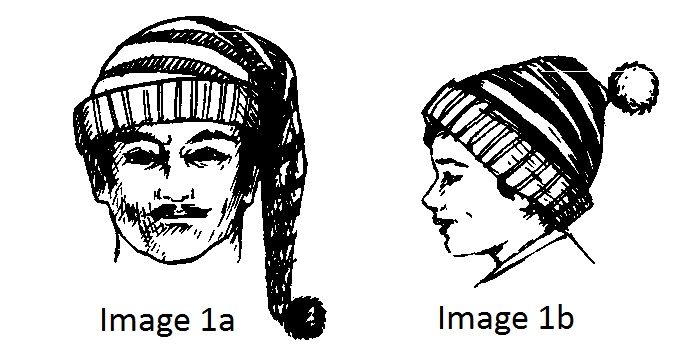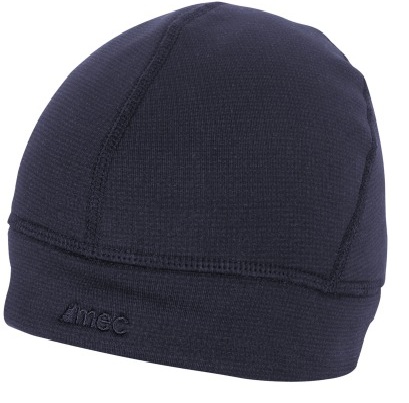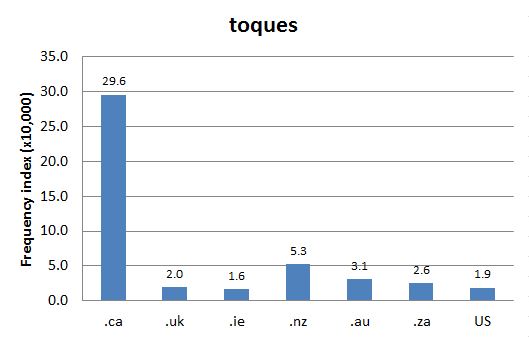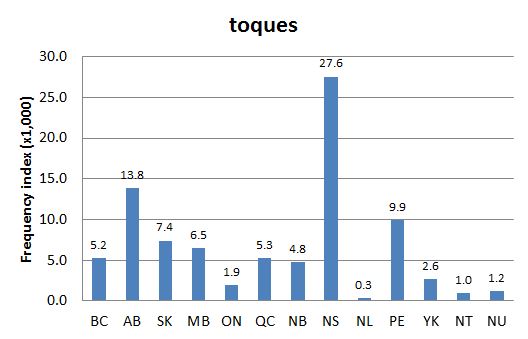DCHP-2
toque tuque, touque invariably [tuːk] < Canadian French, variant of tuque DCHP-2 (April 2017)
n. — Clothing
a close-fitting knitted hat (see images and fist note).
Type: 1. Origin — Toque was borrowed into English from French and has been used to designate certain kinds of hats since the 16th century (OED-3, s.v. "toque"), including chefs' hats and lawyers' hats. Toque may also refer to a style of women's hat fashionable in North America in the late nineteenth century.
In Canada, this word and the spelling tuque was likely borrowed from Canadian French, as the hat was associated with French Canadians (see the 1865 quotation). The OED marks this spelling as Canadian, although its first quotation in the entry is from 1871 from the American Scribner's Magazine (OED-3, s.v. "tuque" ). However, it is from a travel story titled "Pictures from Canada" focused on Quebec. DARE, s.v. "tuque", lists a Wisconsin quotation from 1856 as the earliest American attestation, with reference to the "yoyageurs", a clear French-Canadian reference.
Voyageurs and lumbermen wore tuques with long tails (see Image 1a); later the meaning was generalized to include those without tails (Images 2 and 3) or pom-poms (see Image 1b). The word is found in Central and Prairie Canada early on (see the 1880 quotation from Manitoba, the 1881 quotation from Ontario, and the 1882 quotation from Alberta). The 1886 quotation below is the earliest occurrence found from British Columbia, which reports an event in Montreal and suggests a dissemination from east to west.
Early Canadian spellings are usually tuque, possibly to discriminate it from the women's hat. Our quotations database shows that a shift towards the o-spellings occurred after this type of women's hat fell out of fashion (see the 1943 quotation). There is even evidence for the variant spelling touque (see the first 2016 quotation); in an informal newspaper survey of 6500 Edmontonians, slightly over 40% chose touque, with toque at 35.5% and tuque at around 18% (see CBC Edmonton reference). Such hats are referred to elsewhere as beanies, stocking caps, or watch caps. As Chart 1 shows, the term is most frequent in Canada. Chart 2 illustrates that toque is found in every province or territory, which makes it a pan-Canadian term.
Toque is also culturally significant as one of the most widely known Canadianisms and is often also used as a generic name for winter hats, at least by younger residents.
See also Gage-1, s.v. "tuque", which is marked "Cdn.", ITP Nelson, s.v. "tuque", which does not label the term Canadian but shows a Canadian connection in an etymological note "Cdn.Fr. < Fr. toque". COD-2, s.v. "toque" (1), which is marked "Cdn", and OED-3, s.v. "tuque", which is marked "Canadian".See also: Canadian tuxedo Teddy Bear Toss
- Today's common spelling toque with the pronunciation in [u] confuses many non-Canadians.
Images:

Image 1: Toque line drawings (DCHP-1, s.v. "tuque")
Image 2: A toque, one of its many modern shapes. Photo: Mountain Equipment Coop
Image 3: A homemade toque. Knitting and Photo: L. Ferreira
Chart 1: Internet Domain Search, 22 Jun. 2016
Chart 2: Regional Domain Search, 22 Jun. 2016

